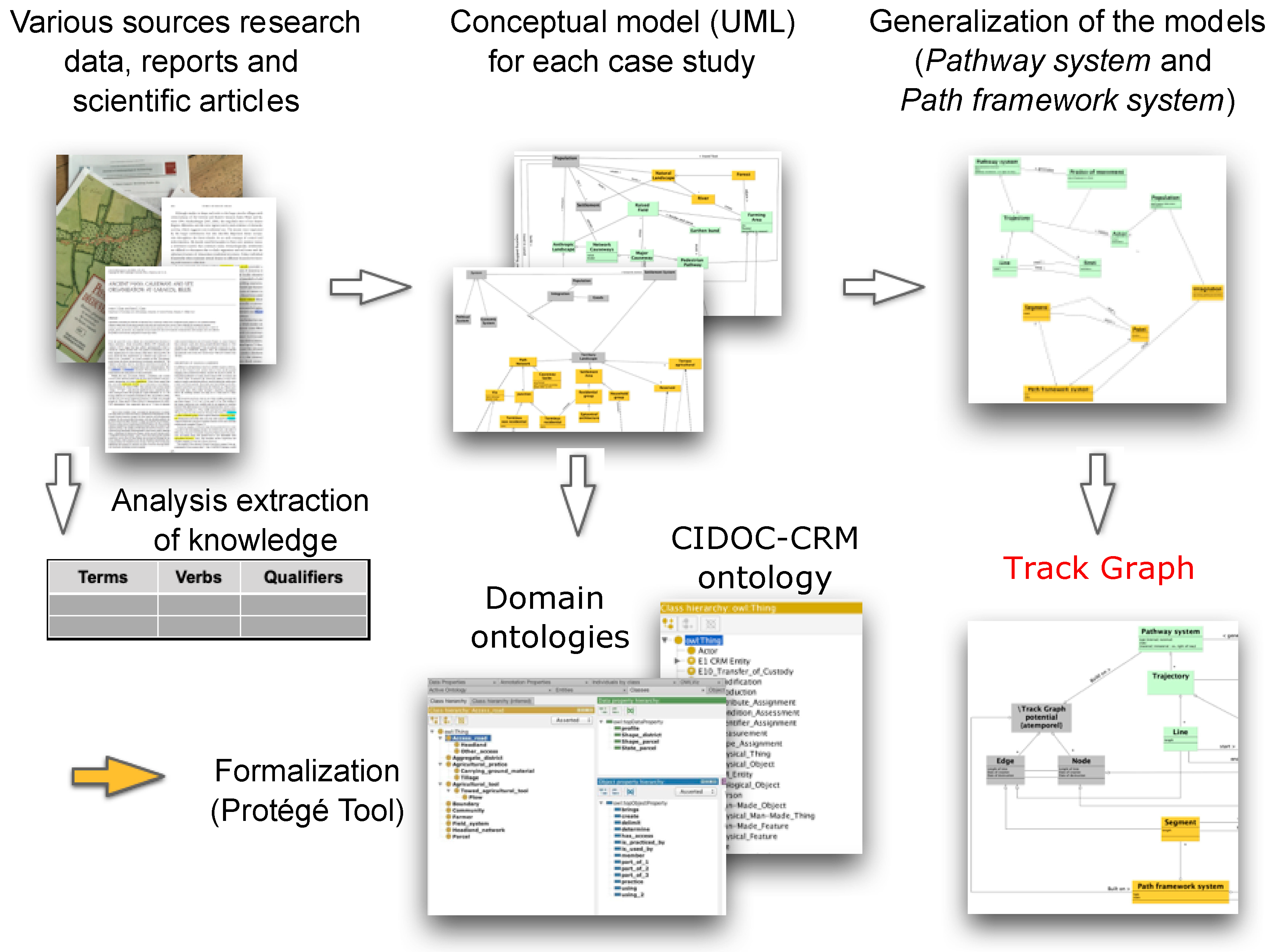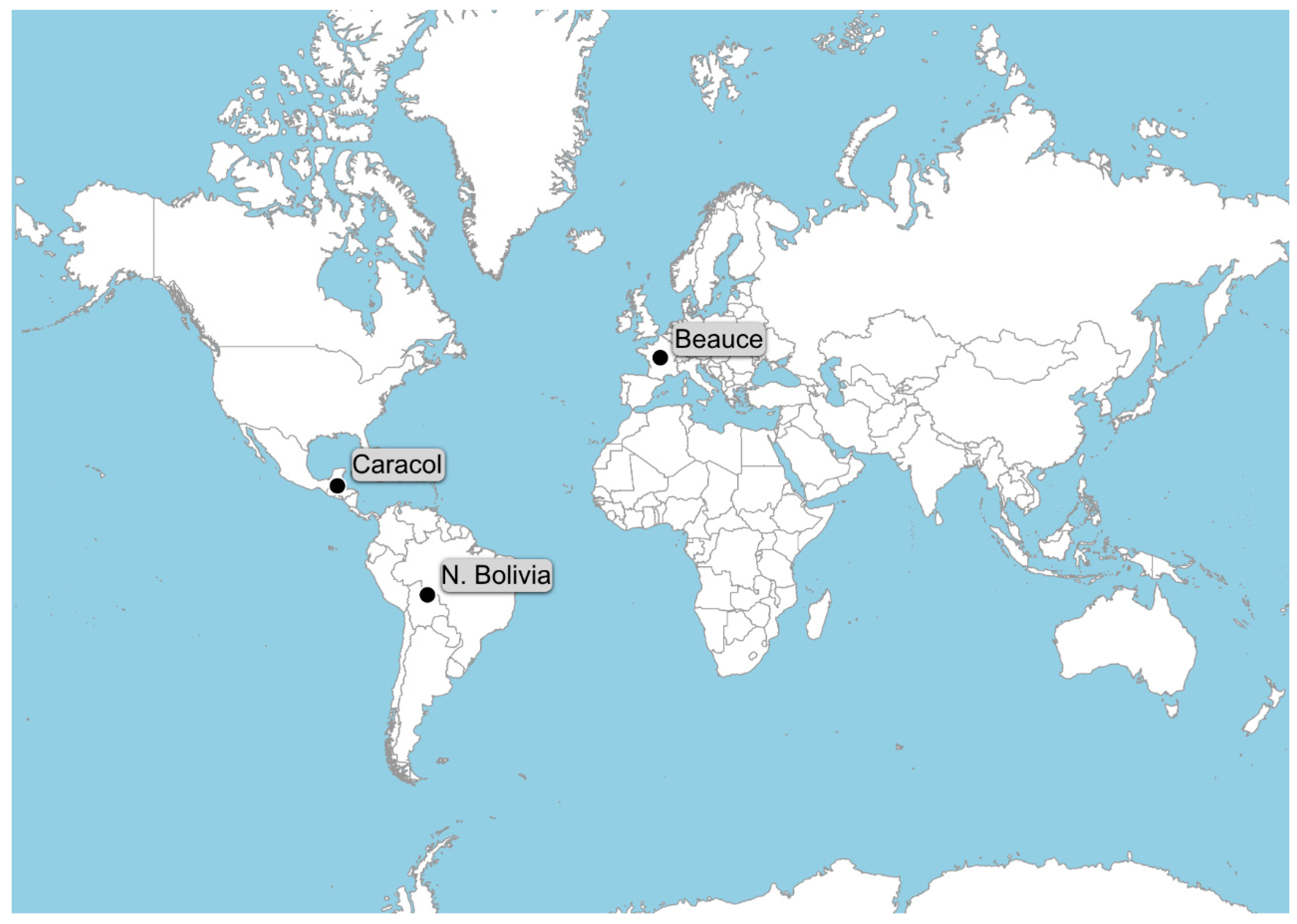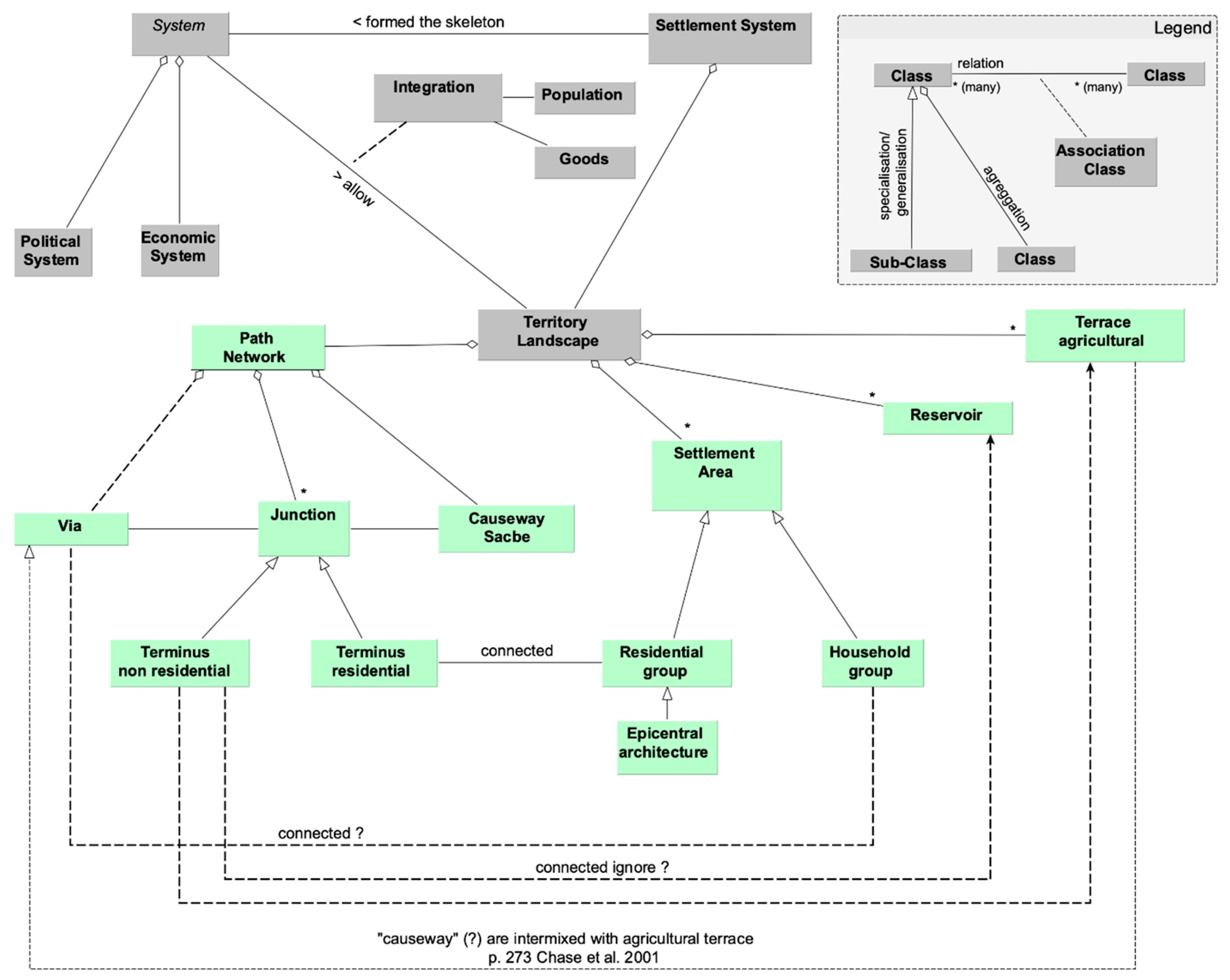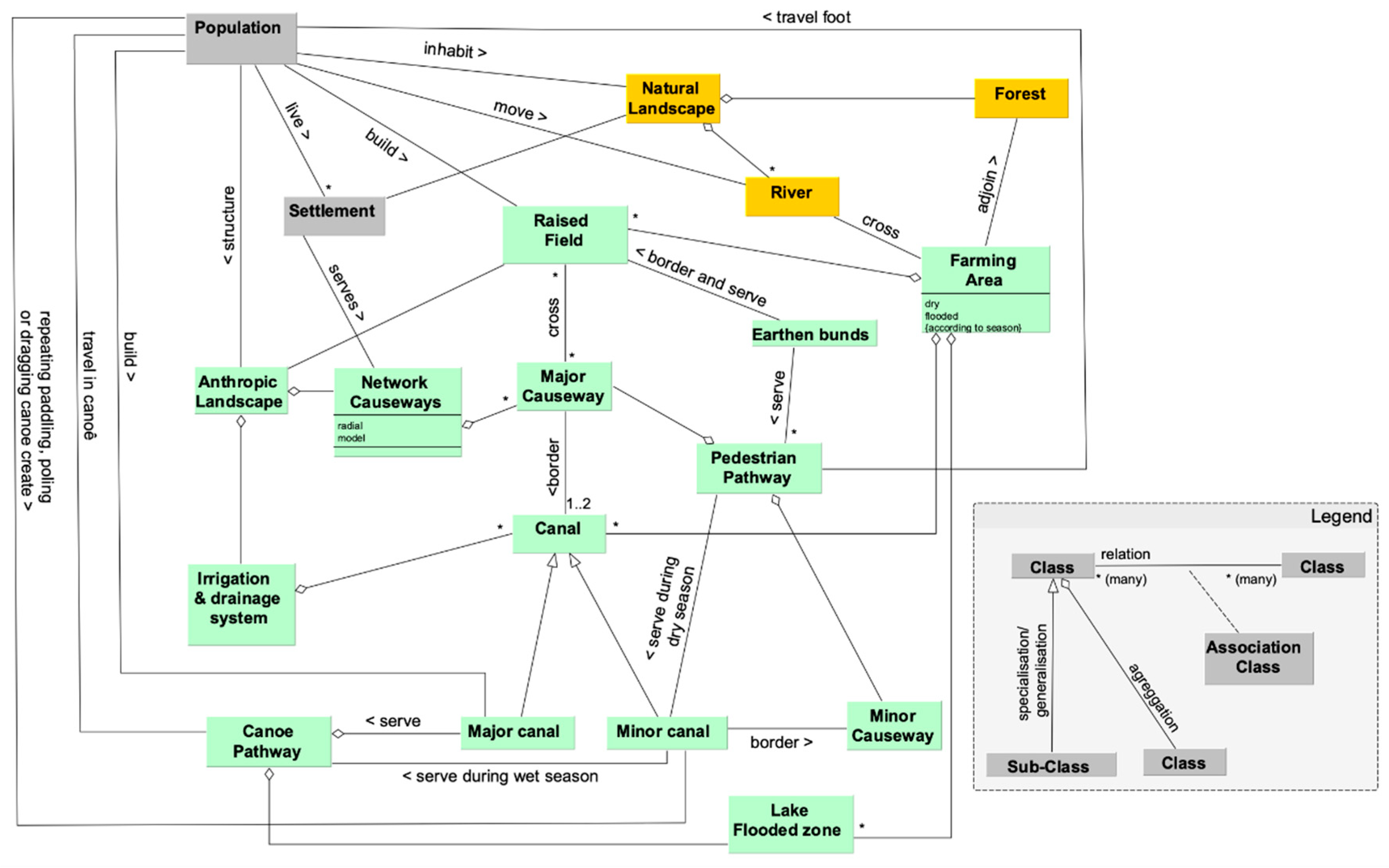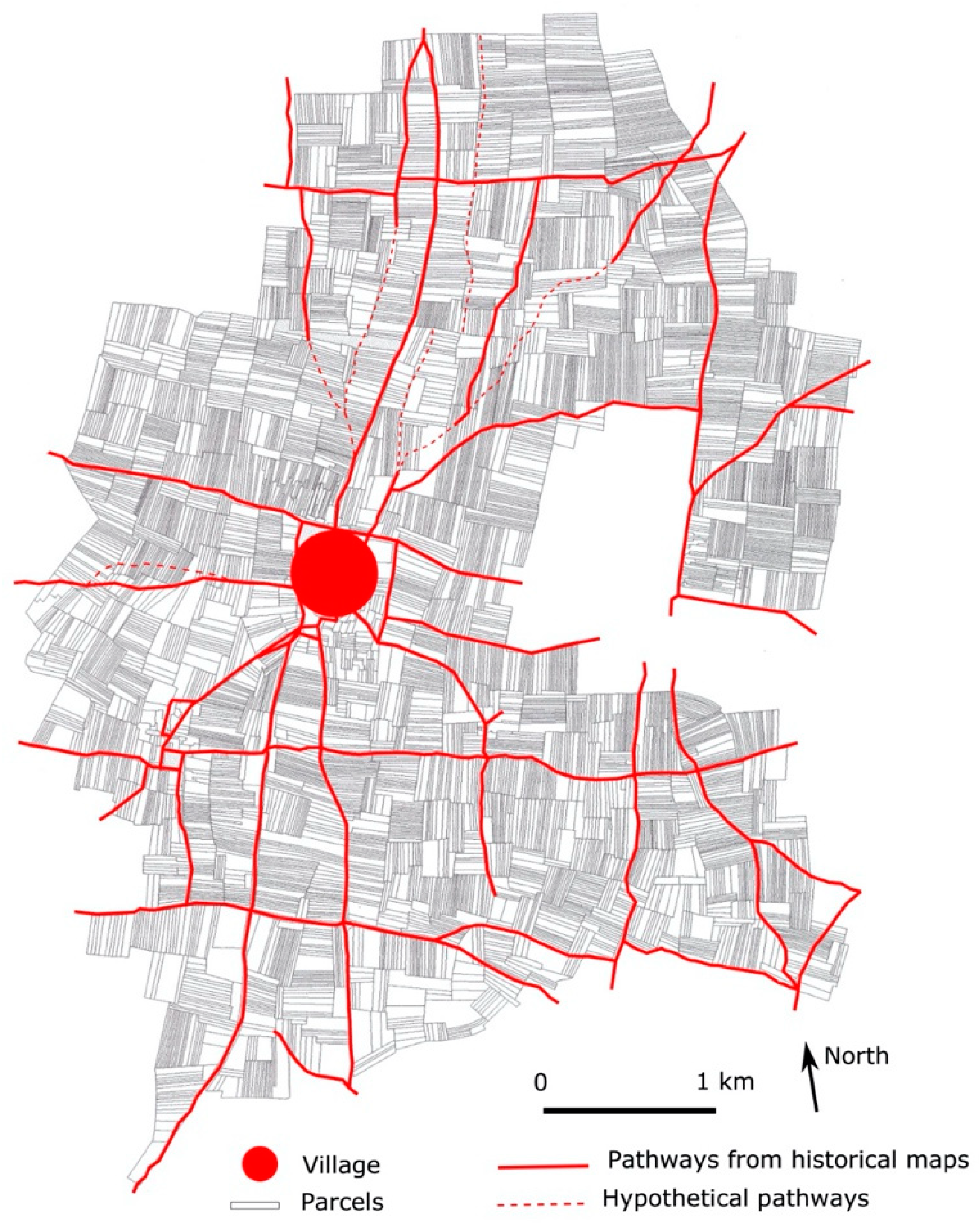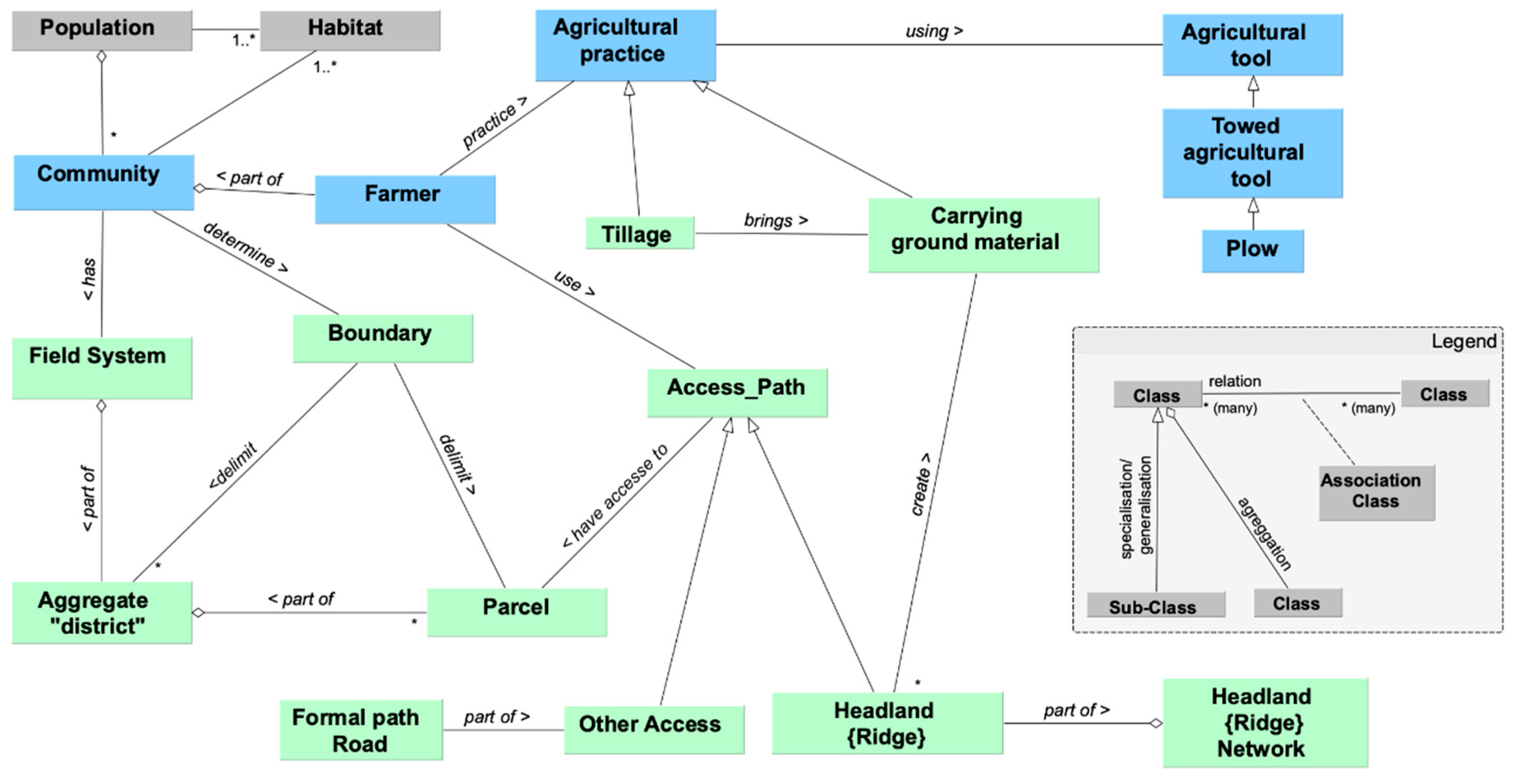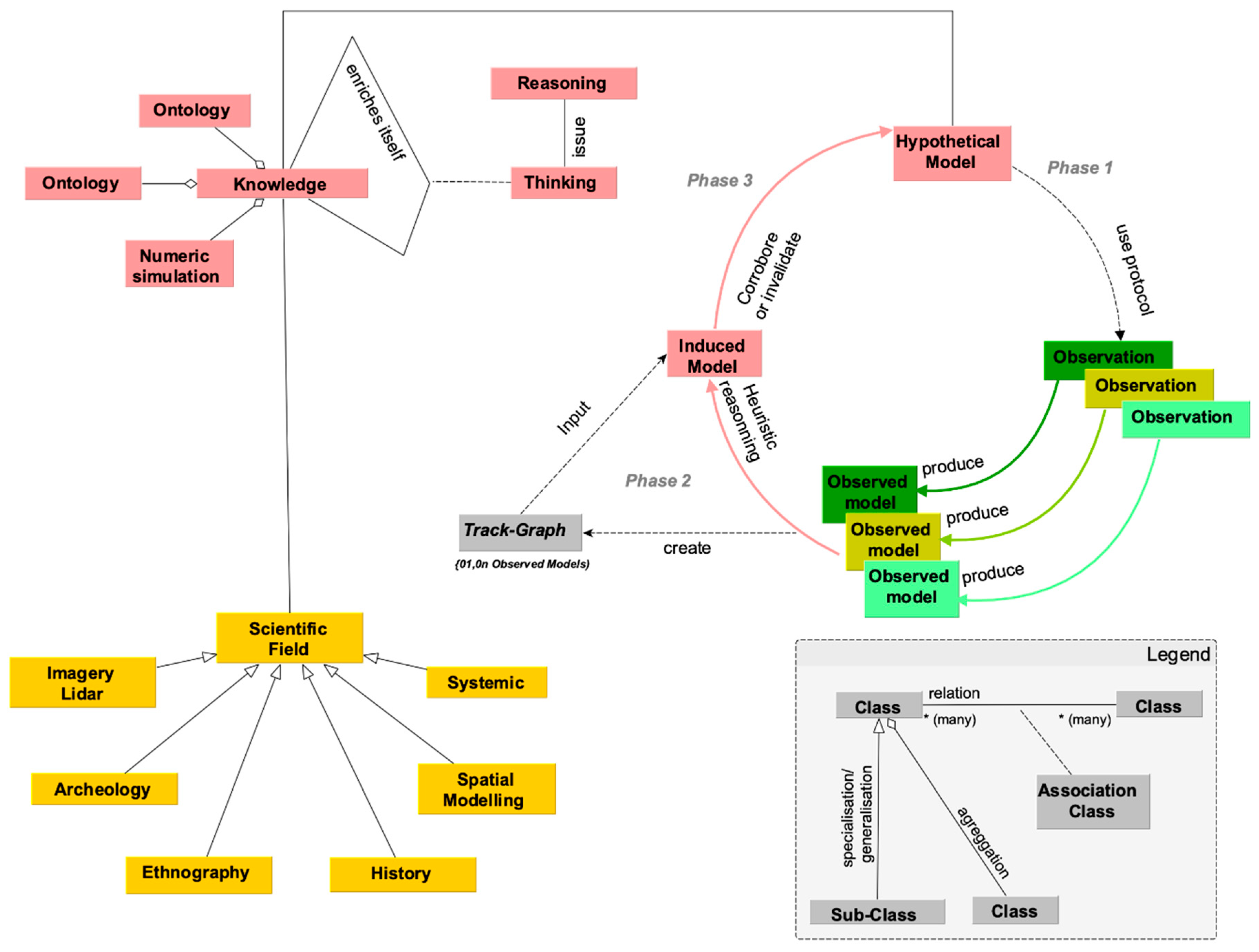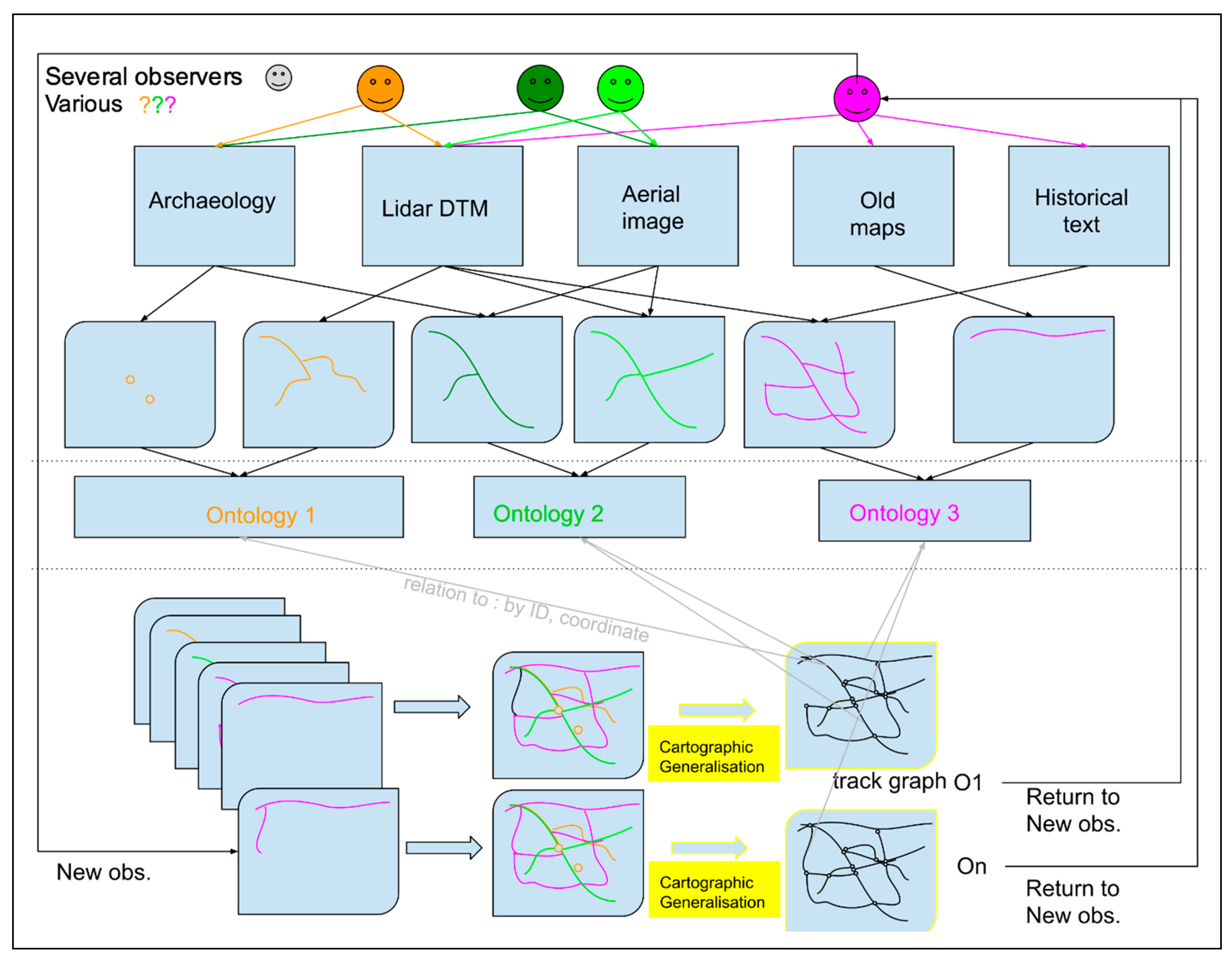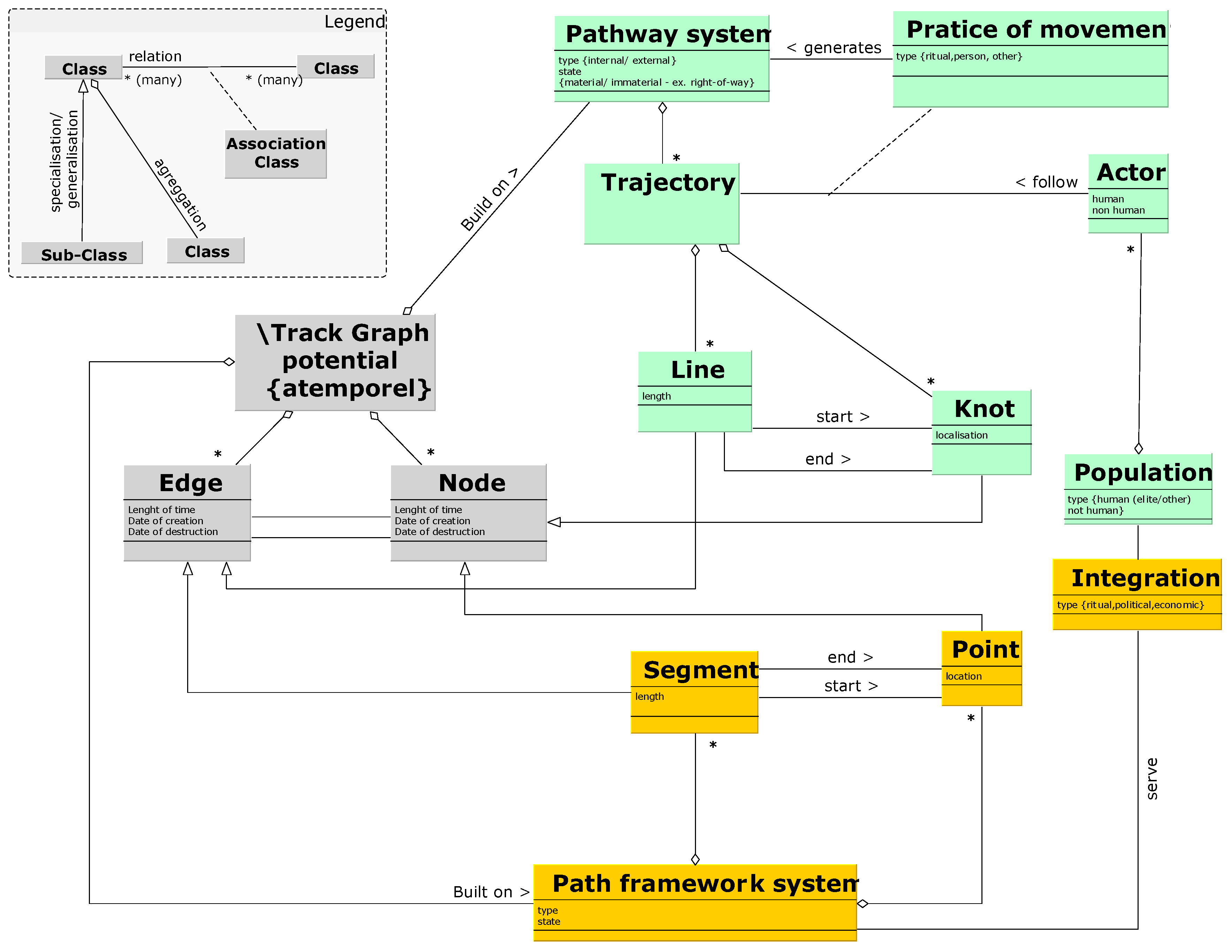1. Introduction
Over the past two decades, the basis for the creation of archaeological knowledge about past societies archaeology has fundamentally changed. This shift has been driven by multiple factors, notably the acceleration of development-led archaeology [
1,
2,
3] and the integration of large digital observational datasets, particularly those acquired through remote sensing methods for earth observation and monitoring [
4,
5], the proliferation of scientific methods applied to gather diverse data [
6], and the increasing digitization of archaeological data [
3,
7,
8].
Within these broader trends, emerging applications of machine learning methods for the identification of features of archaeological interest in remote sensing derived datasets (e.g., [
9,
10]) are causing a particularly important change in knowledge production practices. The machine learning methods being applied in many archaeological remote sensing projects take as an input examples of features which represent different types of entities. For example, a project team studying field clearance as a practice might seek to provide examples to an algorithm of the “most important” types of features related to field clearance activities. The research team might provide examples of round cairns, linear cairns, irregular cairns, and field boundary walls, which based on their knowledge at the time were the most relevant feature types. The algorithm learns to identify features similar to these input examples, and when applied it does so quickly and at an extensive scale. This method, in multiplying the identified examples of features of a type similar to the examples used as inputs, rapidly reinforces the dominance of those types of features in the archaeological record. An unintended consequence of this process is that features which were not considered important when designing the machine learning project could be further marginalized within the archaeological record, as the existing state of knowledge of the project team and their research biases are reproduced and reinforced at an unprecedented scale. This problem of “circular reasoning” and “finding more of what you expect to find”, posed by the strong reinforcement through machine learning of implicit ideas and knowledge about what physical features represent different activities and processes, has been noted by researchers working in this domain [
11,
12,
13], particularly in the context of the transfer of these algorithms between different environmental or archaeological contexts.
Two key sources which inform the implicit ideas and knowledge base of teams working in this context are the domain-specific literature on the activity or process they aim to study, as well as prior identifications in remote sensing data by expert interpreters of features related to that activity or process. To address part of this problem of strong reinforcement of implicit knowledge, we propose an approach to integrating a re-reading of the rich but challenging written archive of archaeological research on a given topic with the existing information structures used in expert identifications of features in remote sensing data sources, focusing on extensive aerial data sources such as those derived from satellite imagery, aerial photography, and airborne laser scanning (lidar). To illustrate this approach, we explore the process of creating archaeological knowledge about past movement and the material evidence of its impact on the landscape.
Using three case studies drawn from the archaeological research literature (primarily journal articles and books), we analyze how researchers have identified and conceptualized the material traces of various movement processes in different regions. Although the case studies are very different in their descriptive vocabularies and the physical remains they discuss, our analysis shows that all of them combine formal pathway systems, characterized by infrastructure intentionally devoted to enabling travel and movement, and informal movement systems, characterized by diverse features and structures which are co-opted to enable movement. As these two systems are not hierarchically integrated but rather intertwined, we propose to introduce a new concept, the “track graph” that aims to record observed material features in the most neutral form possible, providing a basis for analyzing the combined systems. Of a purely analytical nature, this abstract “track graph” concept can be employed to reconstruct trajectories that follow various types of movement logic.
We outline our approach to constructing ontologies, in this paper’s example built around the “track graph”, through which we explicitly relate material elements identified in observational data from remote sensing or field-based surveys to a body of knowledge or theory as expressed in the written research, in this paper’s example about movement. Movement is a particularly useful topic through which to explore our proposed approach because as a concept it integrates diverse practices, manifested archaeologically through varied physical forms, and it has been approached in quite different ways by researchers working in different contexts. It presents the kind of intellectual complexity, shared by many topics salient to contemporary research on archaeological landscapes, which requires us to grapple with core issues of knowledge creation.
2. Biases Affecting the Corpus of Physical Features Used as Evidence of Movement
As we noted above, there are two key sources which inform new identifications of features as evidence of past movement: domain literature and past expert identifications in observational datasets (remote sensing) or field observations. Each of these are affected by inter-related methodological, observational, contextual, and semantic biases. These biases are well known, as they impact on most observational datasets created and used by archaeologists, and we summarize the key impacts for studies of movement here.
Methodological biases: The choice of remote sensing technique and the design of the survey affect the probability of detecting features, depending on their specific physical characteristics. Some techniques are better for observing features on the ground surface and others for detecting features below the surface. Some are more suitable for detecting smaller features, while others will only reveal features under specific conditions of lighting, soil humidity, or vegetation cover [
14,
15]. Survey design choices related to areal coverage and spatial resolution have significant effects on detection probabilities [
15,
16].
Observational biases: Observers tend to recognize features similar to those they have seen before [
11], so an observer’s familiarity with features has a significant impact on the frequency of recognition (see, e.g., [
12]). Observational bias may lead to false positives as well as false negatives.
Contextual biases: Some features are easily identified and interpreted in isolation, because they have an unequivocal physical expression that cannot be mistaken for something else. However, in most cases we need an understanding of a feature’s context in order to correctly identify it [
17], taking into account environmental, cultural, and historical context [
18]. Certain environmental conditions will enhance or suppress the physical expression of some features, e.g., because they are easily eroded, leading to potential misidentifications. Equally, if contextual information about the known activities in a region at different periods is lacking or incorrectly interpreted, the identification of features may be erroneous [
19], a situation complicated by the changing use of physical features over time [
20].
Semantic biases: The assignment of a feature to a specific class or type may be a source of disagreement between observers, since the two observers may draw on different classifications and typological systems. Further, even when notionally working within the same system, these two observers might rely on different implicit ideas about the character or function of a feature belonging to each class, using the same term to indicate and imply different things, further complicating the effects of this bias [
21]. This problem is only increased when communicating across languages, and it is the basis of many problems associated with cross-linking datasets. Even if we know that
crêtes de labour in French are translated as
headlands in English, are we sure that these are really the same thing? Do other observers understand these terms in the same way? Further complicating matters, the meaning of these terms can change over time as the research context evolves [
19].
2.1. Focusing on Observational Biases: How to Recognize a Path
When looking for material and physical traces of movement, both in the field or in the “digital terrain” created from aerial and satellite remote sensing data, all these biases are at play. Our eyes will follow linear features that we immediately “translate” as roads, trails, or trackways. In the field, we can walk along a stretch of an unconstructed path, describing its changing shape, drawing associations with artefacts or features nearby, and recognizing when it merges with the built environment, for example as a causeway. When this walked segment is recognized on digital imagery or terrain models, a process in itself affected by methodological and observational biases, its field-based description is then implicitly extended to the whole linear form observed from the aerial point of view.
This field-based description and its direct aerial-view correlate become the knowledge model used to recognize morphologically similar features in aerial imagery and terrain models as paths. Through this process, particularly when accelerated through machine learning applications, the generalization of field observations through extensive remote sensing datasets will reinforce existing ideas. This interpretive practice does not lend itself to insights into different systems of movement which do not align with our field experience, which is itself embedded in received ideas of what physical features related to movement should look like, ideas developed and reproduced through the literature and affected by semantic and contextual biases. In sum, through our practices of engaging with the literature, field observation, lidar-derived digital terrain models (LDTMs), and complementary remote sensing datasets, we have enhanced our ability to see more of what we already know.
The impact of these inter-related biases can be seen in projects that have generated spatially extensive but semantically narrow datasets. For example, projects working in Central America have identified extensive evidence for major Maya causeways, usually called
sakbeh (white, constructed roads) [
22]. This type of road is well known from the fieldwork, and its connection to the major cities of the Mayan world is well established [
23,
24], with key exemplars of the type well mapped and recognized as part of a network. Integration of this existing knowledge base with new observational data from lidar provided an extensive overview of this causeway system [
25]. The knowledge gained from the lidar data, however, is only relevant to the major transport network defined by these features. It does not extend our knowledge of different types of movement in this landscape and the traces these might leave.
In another context, in eastern France, we encounter a similar situation. Thousands of features related to paths can be identified in the LDTM, based on ideas of paths drawn from fieldwork and literature. In this area, the physical manifestations of paths appear as a tangle, often lacking clear endpoints because they are only partly preserved or visible in the LDTM (
Figure 1). While we know the location and parts of the course of many more paths as the result of this digital survey work, insight into different types of movement and interconnections between different networks of features that make up this tangle remain elusive, as the impacts of methodological and observational biases result in an incomplete picture.
Beyond the methodological and observational biases that impact our knowledge creation practices when drawing on observational data, we face semantic and contextual biases when developing data models, typologies, and classification systems, as we seek to organize and make sense out of the tangle of features identified and sought in the observational data. While some methodological biases can be accounted for in a straightforward way, for example, data resolution will have an easy to understand impact on our ability to recognize features smaller than a certain size, semantic biases can be more challenging to assess and understand.
2.2. Focusing on Semantic Biases: What Words to Use to Describe A Path
While reading many papers addressing the subject of movement we observed that archaeologists, whatever their field of expertise, employ various words to describe pathways, such as path, trail, road, corridor, causeway-canal, or causeway. The terminology adopted, however, is almost never substantiated and this use of implicit definitions makes comparisons between case studies or their integration difficult.
For example, in a cross-cultural Franco-English study the use of implicit definitions is particularly problematic because some terms which are used as translational matches are not true semantic equivalents. The word “
chemin” in French is semantically equivalent to the English word “trail”, whereas “
sentier” would be more like “path”. However, the English word “path” is usually directly translated into “
chemin” creating a strong ambiguity. Beyond these problems of semantic mistranslation, depending on the socio-cultural context, the terms chosen may imply other meanings beyond that related to movement. The term
beh in the Yucatec Maya language is a good example of this situation. According to Keller [
22], it has both a literal and metaphorical meaning. It implies the idea of displacement in space but also in calendar time. It also implies the idea of work done and/or completed, as well as the ideas of life course, prosperity, and destiny. These additional meanings pose further problems for translation to a different cultural context.
In 2009, to address this problem of terminology, Timothy Earle [
27] suggested a working typology to study paths, trails, and roads within a comparative perspective in order to examine their distribution and function. In his approach, Earle considers
paths as “local trodden ways” with an “essentially individual” function, associated with daily tasks and with a low investment in their construction. A path is by nature ephemeral and “largely unrecognizable” in ploughed fields, for example. Paths are associated with local scale “household movements” and with logistical activities and daily use.
Trails are more permanent routes “marked by repeated use, by signs such as blazes, cairns, and petroglyphs, and on maps”. Contrary to paths, trails are “regional or long-distance routes”. Their function is logistical and ceremonial and therefore “trail use is both individual and group oriented”. Finally,
roads are constructed routes which need labor investment and “chiefdom and state” political integration to be planned. Roads “formalize movement” and their functions are ceremonial and military. They are mostly regional in scale, with segments of long-distance routes sometimes also serving as local routes.
A close reading of this typology raises several problems. Earle, himself, recognized many of them and concluded that through his typology the “examination of variation in routes of movement shows the alternative ways that societies operate and change under contrasting sociopolitical and environmental conditions”, and that the static model was not entirely satisfactory. He suggested, “that routine methods should be developed to describe and analyze them [routes of movement]” which would allow for greater diversity to be taken into account“, and that the analysis of variation in routes “offers great insight into the essence of human societies and their evolution”. Reviewing the difficulties posed by Earle’s typology in detail provides a useful mechanism for highlighting broader issues of semantic bias.
Earle’s typology implies that under the same very generic terms we will find a set of material and physical traces that are morphologically relatively homogeneous. However, in both his own study and more broadly, we contend that field observations provide a more complex picture from the outset, and the distinction between road and path is not always clear. For example, Hyslop [
28] reminds us that for the Inka world the same route can vary from a formally constructed road to a simple path over only a few kilometers. The same type of observation about the variable physical form of a road was made regarding “Caesar’s Causeway” in France during excavations carried out along its route [
29].
His typology also illustrates the implicit links that can arise between typologies and models of social structures. Earle’s typology is embedded in a strong model of social hierarchy which associates forms of movement infrastructure with stratified levels of social complexity. A level of social and political organization is attached to each term and its associated set of morphological evidence, as is a specific geographical scale that determines the structure of the traffic system. Therefore, the definition of a physical feature using one of these terms implicitly gives it the particular function and status associated with that term. This association between a term, function, and status is a common semantic bias problem. By associating morphological entities with specific functions, scales, and social hierarchy levels which are all associated with a single word, we reduce our ability to grasp the social complexity of movement.
Even with full knowledge of the complications and nuance implicit in the words used in the definition of any class or type, and when only using a working typology or informal schema, these problems are present. Further, in a classification system with single, fixed semantic categories, wherein a route can only be classified as a road and not as both a road and a path, the infrastructure created through and enabling movement is thought of as single-purpose, rather than as involved in several movement-related activities. The use of systems or working typologies that assign features to a single class or single type might be appropriate for discussing the components of an idealized communication network that has been planned and organized into hierarchical levels. However, they are less effective for describing the structure that supports the movement processes of individuals or groups of individuals as they renegotiate their journeys depending on their activities, social rules and technical capabilities, and on the landscape’s opportunities to move around [
30,
31]. For example, in applying Earle’s working typology, which assigns features to single classes, a team might assign all the diverse constituent features which are recombined ad hoc to form diverse types of paths and are associated with multiple types of movement to the a single class of “path”, and in doing this they implicitly reinforce a hierarchical view of systems of movement.
When considering change over time, the assignment to single categories is again problematic because a simple path can become a road and conversely a road can “degenerate” into a path due to lack of maintenance or change of purpose [
32]. Returning to the embeddedness of typologies in general models of social structures, we note that behind the distinction between road and path there is usually an evolutionary conception of the world and an implied equation of growth and increase in size or material consumption with progress, with roads being associated with a certain, increased degree of societal complexity [
33]. Therefore, as soon as we order the material evidence into classes of pathways, we implicitly include a hierarchy in their function as well as in their spatial and temporal scale. Through these various mechanisms, the act of assigning features to classes as part of the interpretive process and the selection of a specific set of classes to which features can be assigned tends to reinforce broader implicit ideas about how processes and activities in the past took place and delimits the realm of possible understandings of the character of the past societies and landscapes in question.
5. Toward an Abstraction: The Track Graph
While, from a theoretical point of view, it is possible to present this complexity on the basis of well-described and relevant examples, it is much more difficult to envisage methods of analyzing it more globally and systematically on the basis of data sets that are, by definition, heterogeneous. How can these pathways composed of heterogeneous trace elements be identified? How to describe and organize the heterogeneous data on physical features and the information relating to movement in order to be able to analyze these pathways? How can all these pathways that structure the flow of movement in the landscape be identified? Attempting to meet this challenge, we propose the definition of a strictly abstract analytical concept based on graph theory which may be operationalized in terms of spatio-temporal analysis, the “track graph” referred to in the opening section of this paper.
5.1. Motivations and Conceptual Workflow
The identifications of the named entities and their relationships are used to define an abstract composite object called a “track graph”. This corresponds to a construct that allows us to interpret movement based on the various features observed regardless of their temporality. The interest of this abstract object lies in its ability to structure data and knowledge to describe the system of movement as a set of potentialities, rather than a juxtaposition of incompatible systems, and in the opportunity it provides for a cross-cultural analysis of movement processes, while keeping the logical link between these processes and the specific features being interpreted in each case study.
This is particularly relevant when considering how we generate knowledge through repeated observation and construction of hypotheses (
Figure 10). In the hermeneutic spiral [
19,
57,
58], the stage of data analysis is crucial in formulating hypotheses and conceptual models. Pattern recognition and hypothesis formulation are often strongly dependent on specific analytical techniques, such as remote sensing, GIS, network analysis, statistics or simulation modeling, which presuppose a formalized structure for the observed data. Therefore, we propose the track graph as a data structure that will allow for a relatively wide range of analytical approaches, based on graph structures. The track graph collapses all (hypothetical) evidence of movement observed, present and past, into a set of nodes and edges that can be supplied with an unlimited array of attributes. These attributes can be associated to each element of the graph through logical reconstruction via ontologies that describe and structure the body of knowledge according to various world views.
From a methodological point of view, we can subdivide our conceptual workflow into three phases (
Figure 10). The first phase is observation from one or more data sources (fieldwork records, imagery, LDTM, maps, historical documents, etc.). The observers identify archaeological features in the available set of data using a shared or individual observation protocol. While this can induce biases (see part 1), we argue that even if they appear inconsistent in the first instance, these different observations can complement each other within a given study area. In order to identify characteristics, observers also pre-interpret them in relation to a particular problem or question, a more or less defined conceptual framework, and a body of knowledge on which their expertise is based. In doing so, they develop hypotheses and an initial conceptual model to drive their observations and the way they will record and interpret them.
The second phase consists of analyzing these observed datasets, considering the way they have been recognized and interpreted from the point of view of the movement process, in order to propose a schema of the concepts used and the links established by the observers to relate various concepts. This is precisely what we attempted to do by applying an ontological approach to each of the case studies analyzed in this article. This exercise makes it possible to select all the characteristics regardless of their name or morphology and to associate them in a generic domain of “potential path”. For instance, agricultural terraces or headland ridges, which are not strictly defined as roads, are nevertheless attached to this generic domain of “potential path”. In the cases studied, the features identified all have a spatial reference that is conventionally represented by lines and points. Within the same study area, these heterogeneous layers of information, grouped under the generic domain, can then be combined. Their cartographic generalization allows them to be represented in the form of an abstract geometric model composed of nodes and edges, which constitutes the track graph.
In the third phase, we can explore the logical reconstruction of plausible paths or even movement patterns, for a given time period. This relies on the track graph together with complementary knowledge and data. In the approach developed here, the track graph is a skeleton of plausible tracks, which define the “playing ground” within which we can explore different hypothetical models of movement practices (induced models) and interpretations using, for example, rule-based or agent-based simulation models. Based on several domains of knowledge (“routes”, “networks”, “trajectories”) organized within different ontologies, we can produce various models of movement. Then, the track graph allows us to identify connections between objects that are coming from different observers and methodologies (see the discussion of bias in
Section 1) related to these models of movement.
Subsequently, the abstract object represented by the track graph can be used to reconstruct several types of significant networks. These may be recontextualized a posteriori with temporal attributes, material expressions and socio-environmental conceptions of movement, and clearly defined by a new ontology based on spatial relationships within the graph’s network and on a set of contextual knowledge. Following this approach, the same set of nodes and edges may be articulated differently depending on the model of mobility chosen. For example, we might compare the articulations produced by a regional transport road or a farmer’s trajectory in the course of his daily activities. An edge, corresponding to an archaeological feature with a specific morphology, can then simultaneously be considered as a formal road segment participating in a planned network, or as part of a trajectory defined by the practice of a farmer’s routine activity.
While these reconstructions remain hypothetical, they have the benefit of being based on all the archaeological evidence observed but being abstracted from the regionally specific frameworks implicated in their attributes. The link to these attributes is maintained by an identifier and geographical coordinates linking each segment to one or more observations with specific attributes and ontologies attached, thus making it possible to return to the initial data during the evaluation phase of the reconstruction.
The third step of this conceptual workflow is still a work in progress. In the remainder of this article, we will therefore focus in more detail on the concept of the “track graph”, its construction, and its articulation with two other concepts coming from our observational ontologies: The “pathways system” and the “path framework system” (discussed in
Section 4).
5.2. Track Graph Composition
We define the track graph as an abstract object, composed of a set of nodes and edges. This approach follows that of representations where geometric entities representing physical features are abstracted from their descriptive attributes, such as the approach formalized in the context of urban archaeology to explore the complexity of the urban fabric [
59]. This permits us to clearly distinguish interpreted properties such as type or class, described in the attributes, from the abstract entity, described through the geometry.
A node may represent a place, such as a city, a marketplace, a single dwelling, a marker in the landscape, or an intersection between paths. Such an intersection could be recognized as a junction or crossroad, a semantically meaningful place, or simply as a crossing of two pathways without any specific semantic meaning, for example, the intersection between an animal trail and a hiking trail. The essential characteristic of a node is that individuals and groups can move between them and through them. In other words, a node in the track graph denotes a potentially meaningful place.
Movement itself takes place on the edges, representing features understood to serve as pathways. These can be assigned various attributes, describing their material manifestations or functions. Through time, intersections and places as well as “pathways” can appear, disappear, and reappear. The track graph records and accumulates each observed feature. This geometric graph is expended as observations are made (
Figure 11). An observation allows the creation of an edge or a set of edges and nodes, and the same edge can correspond to several observations (from various observers, and/or various sources, at different observation times or according to different protocols).
Edges and nodes are given an ID and spatial coordinates that maintain a link to the initial observations which are described by a set of attributes via an ontology. While some of these attributes are purely descriptive, e.g., size, height, width, length, materials, spectral signature, topological attributes (crossing, next to, etc.), and consequently will not change between different ontological schemas, other attributes, e.g., class or type, might change between schemas. This compartmentalized approach allows nodes and edges to have different attribute sets for each ontological schema and each set of observations. For example, a researcher visually interpreting a LDTM could identify and interpret a linear topographic anomaly as a part of a Roman road. The same feature could be identified and interpreted by a Medieval archaeologist as a field boundary or as a potential pathway for farmers. This type of interpretational controversy is quite common and the source of heated debates when a research team is investigating the development of a landscape [
60]. Equally, studies combining multiple surveys for a single area highlight the complexities that arise when combining interpretations generated by multiple teams [
61]. The track graph allows us to combine these diverse sets of observations, acting as a dynamic representation of observations, evolving as new ones are made. The track graph constitutes a shared abstract canvas or skeleton that can be used to recompose meaningful systems which can be associated with different worldviews and conceptions of movement.
A single observation, for example a line identified on an aerial image, can also be represented as a set of edges connected by nodes. In this case, the nodes do not have the role of origin or destination but will only link edges to geometrically represent an entity, while some may contribute by representing other observations. This highly abstract structure has several advantages. One is that it allows nodes and edges to be treated as active or inactive. For example, in a set of edges and nodes that represent a Roman road, one of the nodes may also correspond to a junction that allows a farmer to join the road from a terrace edge passageway. In the first case, the node cannot be related to any semantic data, it is a simple graphical convention and is therefore inactive in the graph when it is analyzed as a network. In the second case, the same node is active since it corresponds to an element that has a semantic role, representing a junction of two or more edges.
In the track graph, the network of active places and pathways is only a subset of the total set of realized places and pathways. This graph structure provides a mechanism through which edges and nodes can be activated for modeling movement at specific points in time. A second interest of the track graph which arises from its abstract nature is the possibility to use it as an analytical framework that can be transposed to several transcultural case studies. This allows for the comparison of patterns of paths based on the same structure, while interpreting each of them using the ontology specific to the community under study.
5.3. Summing Up and Making Connections: Track Graphs, Pathway Systems, and Path Framework Systems
In this paper, we illustrated our approach to developing formal models of two types of logic which underpin processes related to movement: The “path framework system” and the “pathway system”, by analyzing a body of literature about a landscape. Then, we explored how these formal models of movement can be leveraged in the interpretation of data from sources such as aerial imagery, LDTMs, field surveys, and historic maps, and how these observations can be integrated through a “track graph”.
To summarize, the “path framework system” and “pathway system” provide complementary models of movement and are intended to be used together. The “path framework system” (
Figure 12) is used to describe a path network designed by a society, or at least recognized as such by a group. This includes formal paths which can be used for transport or travel from an origin to a destination. In this conceptual framework, movement is essentially destination-oriented [
62]. In developing territorial models, the “path framework system” could be used to model how formal systems of movement contribute to the social, political, or cultural integration of the population.
The “pathway system” is used to describe the trajectory produced by one or more actors through the performance of their activities. This trajectory is essentially informal, although it may include components of the formal road system. In the “pathway system”, the movement is activity oriented rather than destination oriented. The movement logic of the “pathway system” could be approached analogously to the wayfaring process, as developed by Ingold [
31], but associated with the idea of habitus [
47,
48], which over the long term produces a collectively created imprint in the landscape.
The “track graph” is a network graph in which each entity (node or edge) represents a physical feature in the landscape, and their physical and spatial connections are represented as connections in the graph. The “track graph” links the two models of movement in a single analytical framework provided by its abstract representation of features in the physical landscape. Unlike the “path framework system” and the “pathway system”, the “track graph” does not contain any interpretations of what the features represented are used for or when they were in use. It only acts as an abstract support for both conceptual frameworks. Its structure, composed of edges and nodes, is simply a convention to facilitate analysis.
In the articulation of the three concepts, the handling of time deserves careful attention. As explained, the “track graph” is a set of nodes and edges that covers the total of all observed and inferred potential paths and places, regardless of their chronological range. In this sense, the “track graph” itself
historically and archaeologically atemporal, conflating features from all periods. At a given moment of observation (O
1), the “track graph” structure records the totality of the realized or potential paths and can be used for exploring plausible paths, using a specific ontology describing movement behaviors and associated knowledge about a given space-time (
Figure 11). New observations may be added to the “track graph”, tagged with their observational moment (O
2…O
n), capturing the development of the understanding of the landscape and movement in it through an iterative process of modeling, observation, and interpretation. The temporality of the “track graph” is related to the time at which the observations are made, at which we have arrived at a particular state of knowledge.
Unlike the “track graph”, the “pathway system” and the “path framework system” are historically and archaeologically temporal. They are chronologically bounded and their dynamics reflect a dynamic that is historically meaningful. In archaeology, we are interested in analyzing patterns and dynamics within a time frame (T) with defined durations (from t0 to tn). Therefore, we can refer to different reconstructions of movement patterns (induced models) as being valid for a particular time frame, defining the nodes and edges that were present at t0, and defining which ones become active or inactive until the end date tn. Thus, within our time frame T, we can have reconstructions R1,…,Rn.
Then, modeling techniques can be used to simulate movement and establish routes within the track graph structure. This is, for example, what happens in an application such as ORBIS (
http://orbis.stanford.edu/), where a network of Roman roads and cities is used to explore different travel routes within the Roman Empire. Within this static network, which forms a typical example of a path framework system, routes can be defined as subsets of nodes and edges that are connected for the purpose of a single, individual journey. These routes can be short or long, straight or circuitous, and can be connected to and nested in other routes. Simulations similar to these can explore various manifestations of one or more movement behaviors at a single point in time, for example focusing on understanding the consequences of uncertainties in data attributes [
63,
64,
65] to assess the plausibility of routes.
Next, we consider the role of nodes in the “track graph”, and how they are used in modeling the trajectories of journeys made within the framework defined by the “pathway system”. The concept of the “pathway system” is rooted in the paradigm of the meshwork, a theoretical framework radically different from that of a network, and consequently any modeling within this meshwork-based paradigm requires a fundamentally different approach [
31]. In a meshwork, we focus on the people who move through the landscape and how their practices of movement cause “knots” to emerge. These “knots” are defined as places where their journey’s trajectories intertwine (an interweaving of lines in Ingold’s language). Visually, these are places where the physical features associated with movement intersect, but which have no semantic meaning for the actors involved in their journeys as they move along these pathways. An example of this kind of knot is the intersection between a paved road and the route taken by a roe or a wild boar moving across the landscape (
Figure 13).
In contrast to the situation in the network paradigm where each node is a point of connection, the knot of the meshwork paradigm is not, a priori, making a meaningful connection between routes. In order to articulate these two conceptions, the network and the meshwork, in a formal and operational model which can be used in graph-based analyses and calculations, we have chosen to treat these knots as nodes within the “track graph”. This is a pragmatic decision taken because when constructing a graph in most current software systems it is a technical necessity that the nodes are present as fixed features, rather than being dynamically generated during the running of an analysis. To reconstruct the plausible paths or the circulation patterns which might have been used by actors moving around the “track graph” at a given moment or period of time, we use attributes to assign a node, acting as an entirely abstract element on the graph, the function of a “connector” (active nodes) or a “knot” (inactive nodes). This approach semantically separates the presence of a node in the graph from its usual function as a connector.
To explore this idea, consider a research exercise in which a team models movement through the landscape at two different moments in time. In the first moment, the junction between a farmers’ path crossing a road has a specific meaning for farmers and is recognized and marked by a group of farmers as a crossroads. Therefore, it is an active node having the function of a connector in the track graph when running a model simulating movement through the system. In the second moment, the formal road exists, but there is no place marked by a group as an official crossroads. In this second moment, although the direction of the farmer’s travel may change, turning from the farm path onto the road, and this may be represented in the simulation as a change of direction between two edges geometrically separated by a node in the “track graph”, this node will have an inactive status because it is not acting as a connector because it is not a “crossroads”—a recognized destination or otherwise meaningful feature in the landscape. The assignment of “active connector” or “inactive knot” attributes to nodes on a graph provides a mechanism through which we can attempt to implement network analysis and modeling approaches dependent on graphs within the conceptual model of a meshwork.
Through dynamic simulation, using an agent-based modeling (ABM) for example, a large set of reconstructed individual trajectories can emerge, using various combinations of the track graph elements, which change at each iteration. The trajectories emerging at ti, based on the modeled behavior of the agents, and related to the pathway system, will lead to the creation of a specific set of “pathways” encapsulated in a set of edges and nodes within the track graph. These sets will have an effect on modeled trajectories in the next iteration at ti+1, because the existence of pathways influences the beliefs and knowledge of subsequent groups of agents. This provides a mechanism for the simulation to drive changes in the attributes of nodes and edges in the “track graph” (e.g., “crossroads”, “path”) from iteration to iteration. Models such as these can be used to validate specific hypotheses, for example if observed formal “path framework systems” could have served other purposes, or if certain movement practices imply or preclude the combined use of path framework and pathway systems.
6. Some Conclusions and Implications of This Approach for Practices of Archaeological Knowledge Creation in the Contemporary Context
In this paper, we presented an approach to archaeologically studying the diverse expressions in the physical landscape of phenomena, such as movement, through a process of semantic modeling of domain literature and observation-based interpretation using fieldwork and remote sensing data. We focused on movement in three contexts, highlighting the variability in archaeologically recognizable physical evidence for movement and in the concepts and language used to describe movement and its infrastructure. The increasing use of extensive remote sensing datasets and, in particular, the uptake of machine learning to scale up identifications of archaeological features in the landscape motivated the development of this approach, which aims to guard against uncritically reinforcing standardized and strongly codified ideas about how complex phenomena appear in these data.
The impact of the current step-change in the scale of available archaeological data on our approaches to interpretation and recording—our practices of knowledge creation—echoes the impact of the vast increase in the amount of archaeological data generated through fieldwork associated with the expansion of development-led archaeology. While the study of relatively small scale artefactual collections and research-led fieldwork, designed to support the observation of material traces of past human behavior through survey and excavation, dominated much archaeological knowledge creation in the first part of the 20th century, the importance of development-led archaeology increased in the late 20th c., accelerated in the 1990s by the new legislation [
66]. This shift in the context of the production of archaeological information, from one primarily constructed around the interests and practices of individual researchers and institutions, and dependent on limited dedicated funding, to one based on the needs and practices of market-driven heritage management, with total funding at a much greater scale, which today continues to increase the scale of archaeological work, led to the proposal and development of new approaches to fieldwork, data collection, and data management [
67,
68,
69]. Adding to the collection of new data from excavation and survey, diverse scientific techniques, from isotope analysis, to micromorphology, to aDNA are increasingly applied in connection with archaeological fieldwork [
6,
70]. These each generate bodies of observational and metric data as well as interpretations, following their own specific standards.
The myriad problems of strongly codified recording and reporting norms associated with the professionalization of archaeology and the attempts of practitioners to deal with their burgeoning data in the late 20th c. have been discussed at length, particularly in the context of excavation [
8,
40]. The standardization of survey recording and reporting practice, motivated by its increasing use for creating archaeological inventories, meeting regulatory requirements, and other forms of heritage management [
71,
72], is similarly recognized as problematic. Despite these widely acknowledged problems, in practice the standardization of recording and reporting for both excavation and survey has increased.
This latest step-change is propelled by improved methods and decreasing costs of collecting extensive observational data, notably through remote sensing methods including satellite imagery, UAV-based sensing, and geophysical prospection. While these datasets have been large by archaeological standards for some time, their scale has grown exponentially in recent years. More importantly, while until recently the archaeological use of these data resources has been constrained by the pace of manual interpretation, improvements in machine learning and automated feature detection, notably since the 2010s (see, e.g., [
4,
5,
73]), are speeding their interpretation.
At present (2020), the imperative for integrating this morass of digital information to produce coherent, compelling, data-embedded archaeological narratives is frequently argued in connection to the archaeology’s ability to contribute to debates on societal, climate, and environmental issues [
3]. This emerging drive to re-articulate archaeological data to address contemporary agendas has implications for the development of new practices of archaeological knowledge creation. There is great potential to re-articulate archival data and synthesis of past research to play an important role in these debates, and to bring to bear the information created through the interpretation of large-scale remote sensing data. However, we must do so thoughtfully. The challenges of re-reading and re-interpreting the records, reports, syntheses, and analyses which emerged from evolving fieldwork practices and contextual understandings, as discussed in the debates over standardization and as illustrated throughout this paper, are substantial. The challenges of the interpretation of remote sensing data, as discussed here, are similarly daunting.
7. Conclusions
This paper illustrates one example of how we might combine and re-articulate the information, as well as ideas produced through working with observational data and synthesis of reports and research literature. We set out to investigate the influence of the use of context- and observer-specific terminology on the study of past movement processes and pathway patterns based on observed features. Our analysis of the terms and interpretive frameworks used to describe pathway systems in three different case studies revealed a discrepancy between how pathways, recognized through fieldwork and on digital imagery, are recognized and interpreted, and the conceptualization of the actual movement practices involved.
In all three case studies, we noted that observed pathways can be the result of formal construction and movement practices (e.g., processional ways), as well as of prolonged informal movement practices that generate non-constructed features (e.g., canoe paths) or make use of features initially constructed for different purposes (e.g., terraces, embankments, or headlands). Movement itself can take place over all these different features, or even leave no observable trace. While the attention of archaeological observers often focuses on formal pathways, understanding a movement “system” of the past is only possible when we connect observations to knowledge of the different practices of movement and the processes of pathway generation, maintenance, and renewal. To refocus our collective attention, we need to consider the role of observer bias, not just in terms of methodologies employed, available data sources, or individual expertise, but bias rooted in how knowledge is expressed in natural language in specific knowledge domains in different cultural and linguistic contexts.
We demonstrated that by creating an ontology of movement practices based on text analysis we can attempt to disentangle, structure, and clarify some of the semantic biases involved in the practice of identifying and interpreting features in large observational datasets as carried out by archaeologists whose knowledge base is inevitably embedded in the literature representing the current state of disciplinary knowledge. In this context, developing ontologies can serve as a useful heuristic exercise, aiding in understanding the reasoning behind largely implicit frames of reference and inference, and supporting comparing diverse situations. The breakdown of implicit conceptual references into explicit, logical chains of reasoning which describe basic entities and their relationships enables the use of constituent elements to reconstruct, analyze, and compare practices, such as those related to movement, from the bottom up.
Then, we introduced the concept of the track graph as a possible analytical tool for exploring and comparing pathway systems and movement practices at multiple spatial and temporal scales. The track graph is defined as a set of nodes and edges representing all observed features in a study region that are related to movement. Based on graph theory, it offers possibilities for applying well-established analytical approaches such as network analysis and agent-based modeling. At the same time, it allows for a richer description and understanding of observed features related to movement through the conceptualization, modeling, and connecting of informal pathway systems, as exemplified by the concepts of wayfaring and meshworks.
While the practical application of this approach to new datasets is still on the horizon, we tried to illustrate the potential and necessity of synthesizing data from various sources using a formalized, but not standardized, approach based on ontological reasoning and basic graph theoretical concepts. We hope that this paper will provide an impetus for developing these concepts and tools further to meet the challenges posed for archaeological knowledge creation by current remote sensing data collection and interpretation practices.


